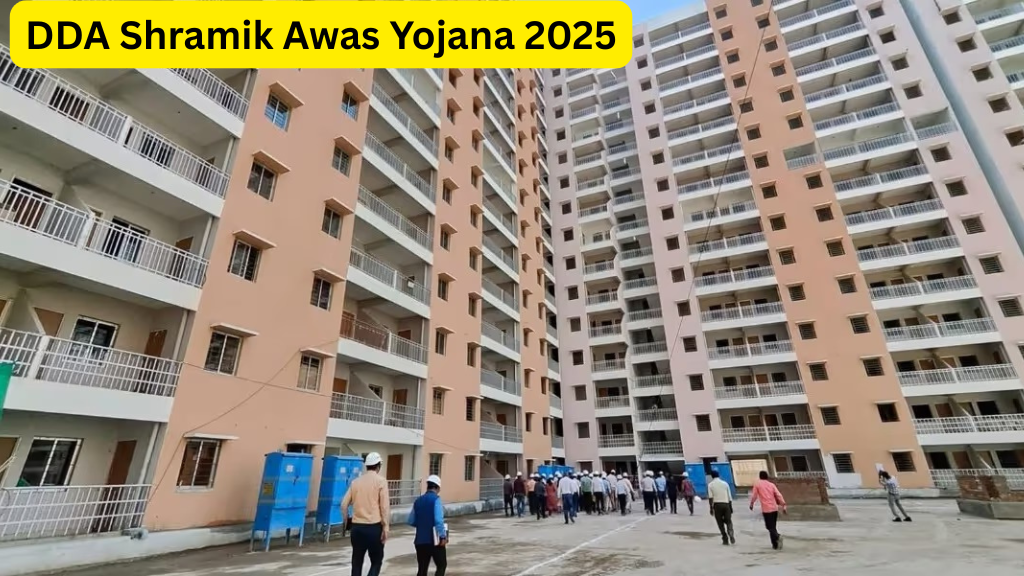
By Platform News Magazine
It was a sticky July afternoon when I first met Meena Devi near the construction site in East Delhi. She was crouched beside a makeshift tent made of old tarpaulin and bamboo poles. Her two children were playing in the dust nearby, their laughter oddly cheerful despite the scorching sun and the smell of diesel from passing trucks.
Meena’s husband worked as a daily wage mason. Every evening, she boiled rice on a kerosene stove and dreamed of one thing — a permanent roof where her kids could sleep in safety.
Fast forward to 2025, Meena no longer lives in a tent. Her family now occupies a one-bedroom flat built under the DDA Shramik Awaas Yojana 2025. It has a kitchen, running water, and even a balcony where her kids grow tulsi and marigold.
This is not just her story — it’s a glimpse into a larger revolution that’s quietly transforming how India supports its backbone: the working class.
What is DDA Shramik Awaas Yojana 2025?
At its heart, the DDA Shramik Awaas Yojana 2025 is a housing scheme by the Delhi Development Authority aimed at supplying low-cost, dignified housing to unstructured sector workers—including masons, electricians, street vendors, domestic workers, and rickshaw pullers.
While earlier schemes have existed, what sets this apart is the scale, transparency, and tech-driven simplicity. For the first time, informal laborers are being placed at the center of urban development, not on its margins.
Why This Scheme Matters More Than Ever
With India’s urban population expected to hit 675 million by 2035, housing needs are exploding. Yet, the workers building our homes, roads, and cities are often the ones left homeless.
The DDA Shramik Awaas Yojana 2025 aims to:
- Provide subsidized flats starting at ₹5–7 lakhs.
- Ensure proximity to job zones and metro lines.
- Incorporate smart infrastructure and energy-efficient design.
- Offer ownership rights instead of temporary leases.
This isn’t just about shelter. It’s about stability, identity, and dignity.
Real Impact: Stories From the Ground
Let’s move beyond stats. Here’s what real success looks like:
Suresh, 29—Daily Wage Labourer, Dwarka Sector 23
“I applied with the help of my union rep. Six months later, I got a letter. Today, I have a kitchen where my mother cooks without inhaling smoke. It’s like winning a lottery — only more permanent.”
Razia Begum, 42—Domestic Worker, Lajpat Nagar
“No one treated us seriously before. Now I’m invited to Resident Welfare meetings. My children feel proud to call this home.”
Their transformation is not just physical. It’s psychological — the confidence to dream bigger.
How to Apply: Step-by-Step Guide for Workers & Families
1. Verify Your Eligibility
- You must be an Indian citizen, 18+, and a worker in the unorganized sector.
- Annual income should not exceed ₹3 lakhs.
- Must not own property in Delhi
2. Get Registered on the DDA Portal
- Visit the official DDA housing website.
- Use your Aadhaar and mobile number to create a profile.
3. Upload Necessary Documents
- Aadhaar card
- Labor card (from the labor department or trade union)
- Income certificate
- Proof of residence in Delhi (minimum 3 years)
4. Pay the Nominal Application Fee
- ₹500 for registration (fully refundable if not selected)
5. Wait for the Lottery Draw
- Transparent digital draw with live streaming
- Selected applicants receive an allotment letter within 30–60 days.
Common Mistakes to Avoid When Applying
- Wrong documentation—Inconsistent addresses between documents can disqualify your application.
- Missing deadlines—Application windows are tight; stay updated through DDA SMS alerts.
- Ignoring union support—Many labor unions have legal aid desks for application help.
- Misunderstanding ownership—These are NOT rentals; ownership titles will be granted after five years of occupancy.
Expert Insights: What Makes This Yojana Different
We spoke with Archana Prasad, a leading urban policy analyst:
“Unlike past schemes that built housing far from job centers, this one integrates livelihood and living space. It’s a true step towards inclusive urbanism.”
She also noted that DDA has tied up with fintech partners to help first-time homeowners manage EMIs and budgeting — a smart move to ensure long-term retention.
Motivation for the Underdog Dreamer
To every daily wager reading this: your contribution to this city is invaluable. You may have been invisible in policy documents until now — but no more.
The DDA Shramik Awaas Yojana 2025 is not just a housing initiative. It’s a recognition of your hard work, your dreams, and your right to live with dignity. You don’t have to stay on the margins. The center of the city is waiting for you.
Frequently Asked Questions (FAQs) About DDA Shramik Awaas Yojana 2025
❓What documents are needed to apply for DDA Shramik Awaas Yojana?
You’ll need an Aadhaar card, an income certificate, a labor registration ID, and proof of residence in Delhi (utility bill, voter ID, or rent agreement).
❓How can I check my application status for DDA Shramik Awaas Yojana 2025?
Log in to the official DDA website, go to the “Application Status” tab, and enter your registration number.
❓Is there any subsidy under DDA Shramik Awaas Yojana for women applicants?
Yes. Single women and widows are given priority allotment and, in some cases, an extra subsidy of ₹50,000.
❓Can workers from other states apply?
Only if they’ve been working and residing in Delhi for a minimum of three continuous years with valid documentation.
❓How will I know if I’ve been selected?
A digital draw will be conducted, and SMS/email alerts will be sent to selected applicants. Also, results will be published on the official DDA portal.
At Platform News Magazine, we believe in reporting stories that uplift, inform, and inspire. If you found this guide helpful, share it with someone who may benefit. Because a home isn’t just a building — it’s a foundation for the future.